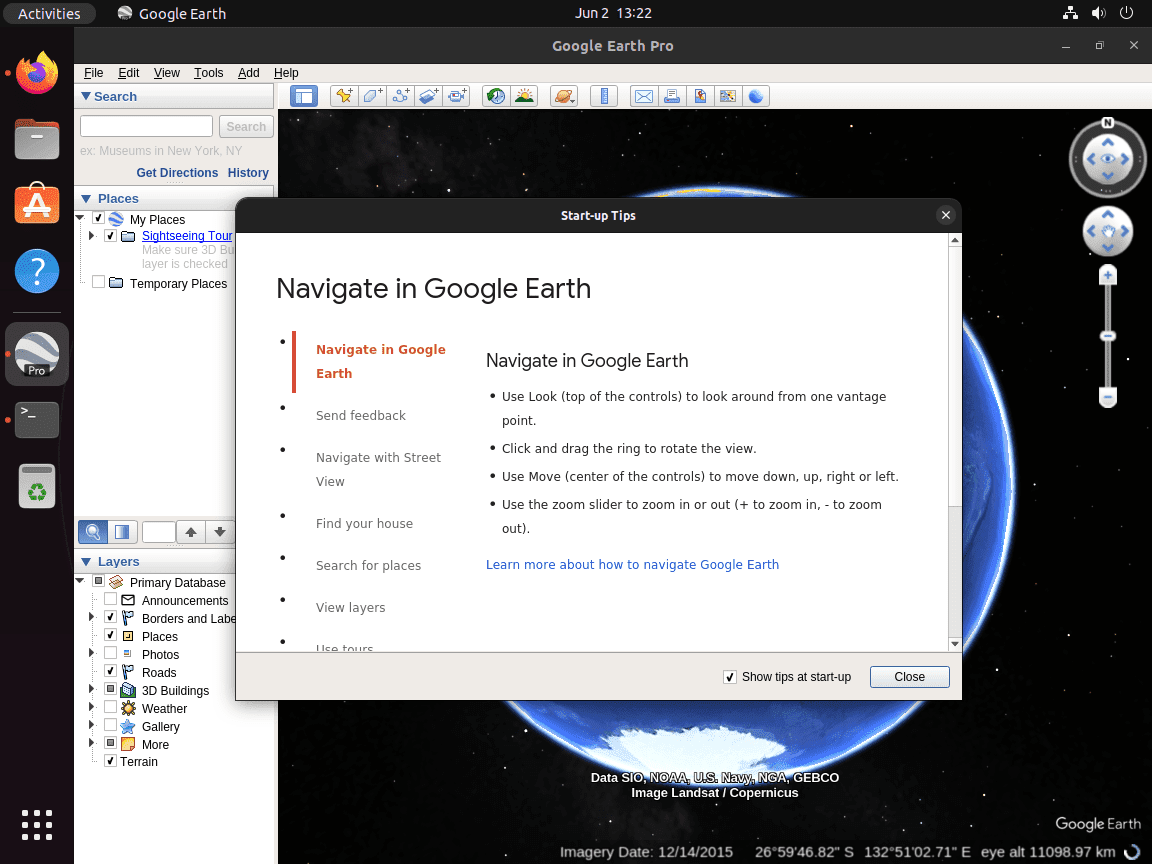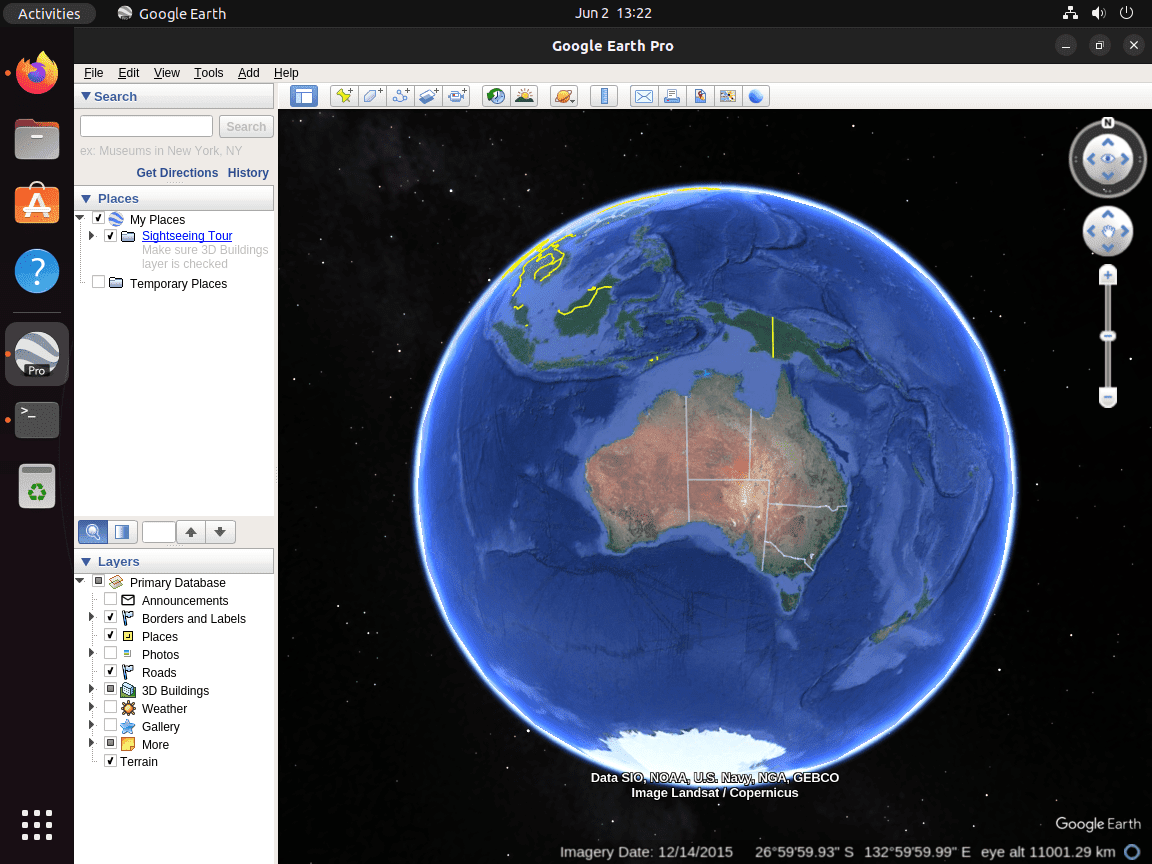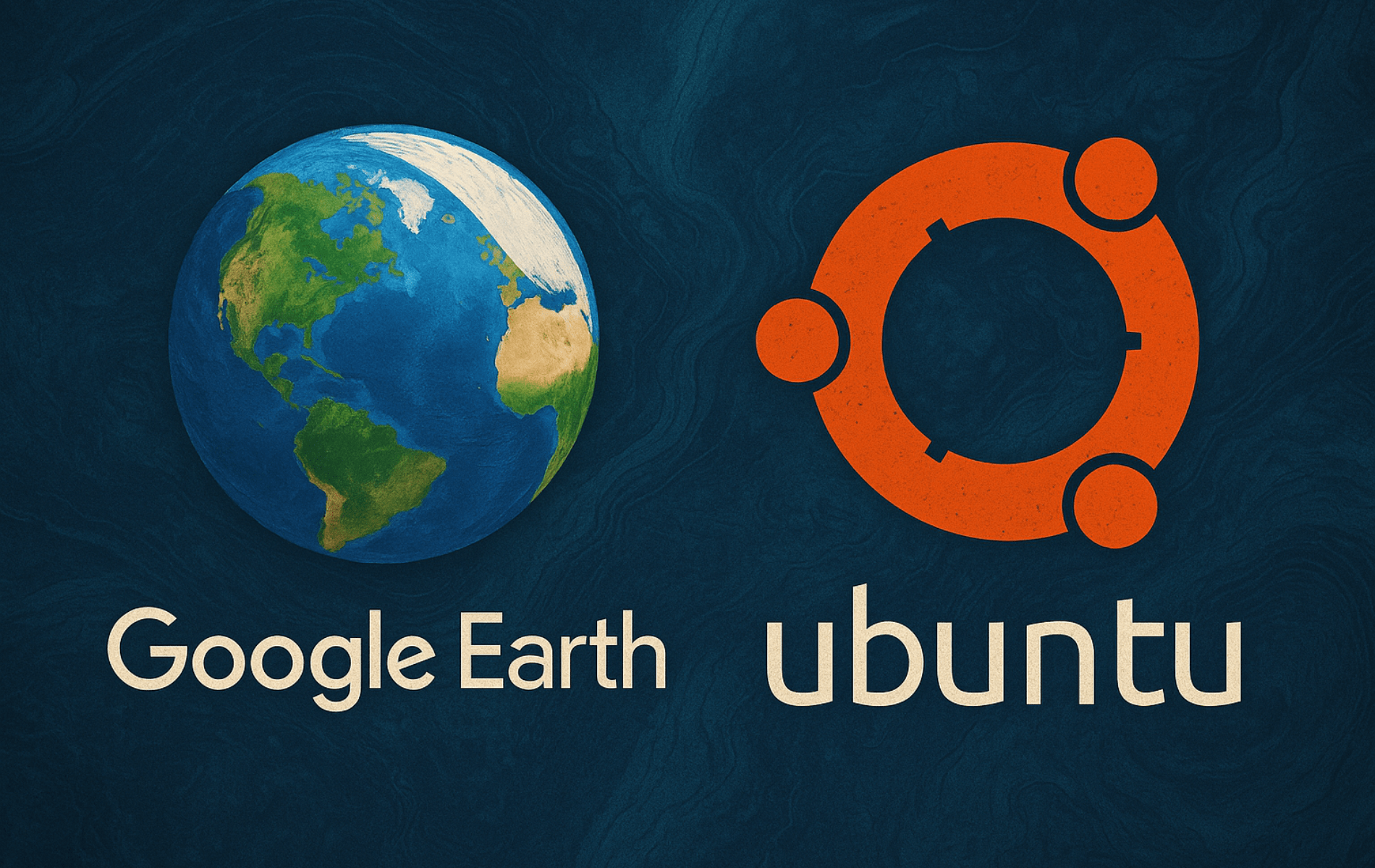Google Earth Pro brings satellite imagery, 3D terrain, and interactive global exploration to your Ubuntu desktop. Whether you need to scout hiking trails, research geographic features for academic projects, plan virtual tours, or explore historical imagery of changing landscapes, Google Earth provides the tools to do it. This guide walks through installing Google Earth Pro on Ubuntu using Google’s official repository, configuring essential settings for smooth performance, and troubleshooting common dependency issues.
Google Earth Pro currently works on Ubuntu 22.04 LTS and Ubuntu 24.04 LTS. Ubuntu 25.10 and newer releases (including the upcoming 26.04 LTS) are not compatible due to a library transition. The
libxml2package Google Earth depends on has been replaced bylibxml2-16in these releases, and Google has not updated their package. If you’re running Ubuntu 25.10 or newer, consider using Google Earth Web in your browser instead.
Before You Install: System Requirements
Google Earth Pro requires a 64-bit Ubuntu system with hardware acceleration for smooth 3D navigation. Make sure your system meets these minimums:
- Operating system: 64-bit Ubuntu desktop or derivative with hardware acceleration enabled.
- CPU and RAM: A dual-core CPU with SSE2 support and at least 2 GB of RAM (4 GB recommended for high-resolution imagery).
- Storage: 2 GB of free disk space for the application and local cache.
- Graphics: GPU or integrated graphics compatible with OpenGL 2.0 or later for fluid globe rendering.
After confirming your hardware meets the requirements, refresh your package lists to avoid dependency conflicts:
sudo apt update
sudo apt upgrade -yThese commands first refresh your package sources and then upgrade outdated packages.
Installing Google Earth
Follow these steps to install Google Earth on Ubuntu and begin exploring the world with its powerful tools.
Check Whether Google Earth Pro Is Already Installed
First, before adding repositories or packages, confirm whether Google Earth Pro already exists on your system:
google-earth-pro --versionIf the command returns a version number, you can skip directly to the update instructions later in this guide. Otherwise, if no version appears, continue with the installation steps below.
Step 1: Install Essential Packages
Install the necessary tools and certificates for secure repository access:
sudo apt install curl software-properties-common ca-certificates -yThis command installs curl for downloading files, software-properties-common for repository management, and certificates for secure HTTPS connections.
Step 2: Add the Google APT Repository
Import the GPG Key
Next, Google provides a GPG key to authenticate the repository and its packages. Import the key by running:
curl -fSsL https://dl.google.com/linux/linux_signing_key.pub | gpg --dearmor | sudo tee /usr/share/keyrings/google-earth.gpg > /dev/nullAdd the Repository
After importing the key, create a modern DEB822 .sources file so APT tracks the Google Earth repository cleanly. This approach mirrors how other Google products like Chrome on Ubuntu handle repository configuration:
cat <<'EOF' | sudo tee /etc/apt/sources.list.d/google-earth.sources
Types: deb
URIs: https://dl.google.com/linux/earth/deb/
Suites: stable
Components: main
Architectures: amd64
Signed-By: /usr/share/keyrings/google-earth.gpg
EOFPrevent Duplicate Repository Entries
The Google Earth installer attempts to recreate a legacy google-earth-pro.list file even when a curated .sources entry already exists. Neutralize that behavior with a read-only placeholder so APT never reports duplicate repositories:
sudo rm -f /etc/apt/sources.list.d/google-earth-pro.list
sudo touch /etc/apt/sources.list.d/google-earth-pro.list
sudo chmod 444 /etc/apt/sources.list.d/google-earth-pro.listStep 3: Update APT and Install Google Earth
Refresh your system’s package list to include the new Google Earth repository:
sudo apt updateOnce the package list updates, install Google Earth Pro with the following command:
sudo apt install google-earth-pro-stable -yVerify the installation completed successfully by checking the version:
google-earth-pro --versionYou should see output similar to:
7.3.6
Step 4: Launch Google Earth
Once installed, you can launch Google Earth using either the terminal or the graphical user interface (GUI).
Launch Google Earth Pro from the Terminal
Run the following command in your terminal to open Google Earth Pro:
google-earth-proOpen Google Earth Pro from the Application Menu
Alternatively, search for “Google Earth Pro” in your application menu and click on the icon to launch the program.
Essential Google Earth Settings and Features
Google Earth offers a versatile set of features to enhance your exploration experience. Follow these tips to make the most of your first-time use.

Performance Optimization Tips
To ensure smooth navigation, adjust these settings to match your hardware capabilities:
- Graphics Settings: Reduce texture quality and disable trees or terrain shadows if you experience lag on modest hardware.
- 3D Buildings: Disable this feature on older systems to improve rendering performance while maintaining detailed map views.
Useful Features to Explore
- Sunlight Tool: Visualize landscapes at different times of day to analyze shadows, seasonal changes, or enjoy scenic views.
- Ocean Layers: Explore underwater terrains, marine ecosystems, trenches, and shipwrecks for educational and interactive discovery.
- Historical Imagery: Use the clock icon in the toolbar to view satellite images over time, perfect for studying urban growth and environmental changes.
Essential Keyboard Shortcuts
- Arrow keys: Pan across the map smoothly.
- Shift + Arrow keys: Rotate the view to explore from different angles.
- Ctrl + Alt + S: Capture a screenshot to save or share your discoveries.

Updating or Removing Google Earth
Keeping Google Earth updated ensures you have the latest features and security patches. If needed, you can also uninstall the application and clean up associated files.
Update Google Earth
To update Google Earth to the latest version, first refresh your system’s package list:
sudo apt updateAfter refreshing the package list, upgrade Google Earth Pro to the latest version:
sudo apt install --only-upgrade google-earth-pro-stableUninstall Google Earth
To remove Google Earth, uninstall the package and clean up orphaned dependencies:
sudo apt remove google-earth-pro-stable -y
sudo apt autoremove -yRemove the repository configuration and GPG key:
sudo rm /etc/apt/sources.list.d/google-earth.sources /etc/apt/sources.list.d/google-earth-pro.list
sudo rm /usr/share/keyrings/google-earth.gpgRefresh the package cache and verify removal:
sudo apt update
apt-cache policy google-earth-pro-stableExpected output confirming the package is no longer available:
N: Unable to locate package google-earth-pro-stable
Troubleshooting Tips
Ubuntu 25.10 and Newer: Unsupported Due to Library Changes
If you’re running Ubuntu 25.10 (Questing Quokka), Ubuntu 26.04 LTS, or any newer release, Google Earth Pro cannot be installed. The installation fails with this error:
Unsatisfied dependencies: google-earth-pro-stable : Depends: libxml2 but it is not installable
This happens because Ubuntu 25.10 and newer replaced the libxml2 package with libxml2-16, which uses a different shared library version (libxml2.so.16 instead of libxml2.so.2). Google’s package explicitly depends on the old library name, and there’s no workaround until Google updates their .deb package.
Check your Ubuntu version to confirm whether this affects you:
lsb_release -rsIf the output shows 25.10 or higher, use Google Earth Web in your browser as an alternative.
Fix libxml2 Dependency Issues on Ubuntu 22.04 and 24.04
On supported Ubuntu versions (22.04 LTS and 24.04 LTS), libxml2 dependency errors typically mean the library isn’t installed. Install it along with development headers:
sudo apt install libxml2 libxml2-dev -yIf the package manager reports libxml2 is already installed but Google Earth still won’t launch, check the installed version:
dpkg -l | grep libxml2Expected output on working systems:
ii libxml2:amd64 2.9.14+dfsg-1.3ubuntu3 amd64 GNOME XML library
Run Google Earth from the terminal to see the exact error message:
google-earth-proIf libxml2 issues persist, reinstall Google Earth Pro completely to rebuild dependency links:
sudo apt remove google-earth-pro-stable
sudo apt autoremove
sudo apt update
sudo apt install google-earth-pro-stable -yFix xdg-icon-resource Error During Installation
On minimal Ubuntu installations or containers, the post-install script may fail with:
Error: Could not find xdg-icon-resource
Install the missing desktop utilities package and complete the configuration:
sudo apt install xdg-utils -y
sudo dpkg --configure -aResolve Repository Conflicts
If you previously installed Google Earth using a different guide or method, you might have duplicate repository entries causing update conflicts. Confirm which files APT sees by listing everything that starts with google in /etc/apt/sources.list.d/:
ls /etc/apt/sources.list.d/google*Keep the curated google-earth.sources file you created earlier and convert any leftover .list files into harmless placeholders so Google’s installer cannot recreate duplicate entries:
sudo rm -f /etc/apt/sources.list.d/google-earth.list /etc/apt/sources.list.d/google-earth-pro.list
sudo touch /etc/apt/sources.list.d/google-earth-pro.list
sudo chmod 444 /etc/apt/sources.list.d/google-earth-pro.listThe
/etc/apt/sources.list.d/google-earth.sourcesfile is the authoritative repository definition. Leave it untouched, and only neutralize legacy.listfiles to prevent “configured multiple times” warnings.
Finally, refresh your package list after cleaning up conflicting entries:
sudo apt updateConclusion
You now have Google Earth Pro configured on Ubuntu 22.04 or 24.04 LTS with repository-based updates, performance settings for smooth 3D navigation, and troubleshooting steps for common dependency issues. Use the historical imagery feature to track landscape changes over time, explore ocean floors with the underwater terrain layers, or plan routes with the measurement tools. For newer Ubuntu releases where Google Earth isn’t compatible, Google Earth Web provides browser-based access to the same satellite imagery and exploration features.


2 December 2025. Hi. Trying the same thing on Ubuntu 25.10 (the new Questing Quokka).
First I downloaded from Google website google-earth-pro-stable_current_amd64.deb
Tried opening the deb with App Center which failed to install (without error messages)
So I tried the steps here from top of the page including Troubleshooting then the comments above
At sudo apt install google-earth-pro-stable -y
“Solving dependencies… Error!
Some packages could not be installed. This may mean that you have
requested an impossible situation or if you are using the unstable
distribution that some required packages have not yet been created
or been moved out of Incoming.
The following information may help to resolve the situation:
Unsatisfied dependencies:
google-earth-pro-stable : Depends: libglu1-mesa but it is not going to be installed
Depends: libxml2 but it is not installable
Error: Unable to satisfy dependencies. Reached two conflicting decisions:
1. google-earth-pro-stable:amd64=7.3.6.10441-r0 is selected for install
2. google-earth-pro-stable:amd64 Depends libxml2
but none of the choices are installable:
[no choices]”
Then at sudo apt install libxml2 libxml-dev -y
“Package libxml2 is not available, but is referred to by another package.
This may mean that the package is missing, has been obsoleted, or
is only available from another source
Error: Package ‘libxml2’ has no installation candidate”
However find usr/lib did find two instances of libxml2.so* on this (brand new, nearly empty) Ubuntu 25.10
/usr/lib/x86_64-linux-gnu/libxml2.so.16
/usr/lib/x86_64-linux-gnu/libxml2.so.16.0.5
Matthew, thanks for the detailed error report. You’ve identified a real compatibility issue that affects Ubuntu 25.10 and newer releases.
Ubuntu 25.10 transitioned from
libxml2(providing libxml2.so.2) tolibxml2-16(providing libxml2.so.16). Google Earth Pro explicitly depends on the olderlibxml2package, which no longer exists in Ubuntu 25.10’s repositories. This is an ABI-breaking change that Google would need to address by rebuilding their package.Unfortunately, there’s no repository workaround for this. The
libxml2-16package cannot satisfy dependencies requiringlibxml2. Your options are to run Ubuntu 24.04 LTS or 22.04 LTS where Google Earth installs without issues, or use a virtual machine running a compatible Ubuntu version.I’ve updated the article with a compatibility warning at the top noting this limitation. Thanks for helping document this issue for other readers on newer Ubuntu releases.
You’re welcome. Thankyou Joshua for guiding us.
I lack accounts for the google/maps&earth developers’ site, so wrote a prompt for Google here:
https://support.google.com/earth/thread/391925027?hl=en&sjid=10638705475203542168-EU
placing a question mark (let’s see what AI does with that! ; ). Not insisting, just asking them.
Thanks for the update.
how TF do I fix a libxml2 issue? earth needs it and I can’t find it and can’t get the terminal to install it
Scott, thanks for reporting this. The libxml2 dependency error typically indicates you’re running Ubuntu 25.10 or a newer development release. Could you confirm your Ubuntu version by running
lsb_release -a?Ubuntu 25.10 replaced the
libxml2package withlibxml2-16, breaking compatibility with Google Earth Pro. If you’re on 25.10, the only current solutions are using Ubuntu 24.04 LTS or 22.04 LTS, or running Google Earth in a VM with a compatible Ubuntu version.If you’re on Ubuntu 24.04 or 22.04 and still seeing this error, let me know and we can troubleshoot further.